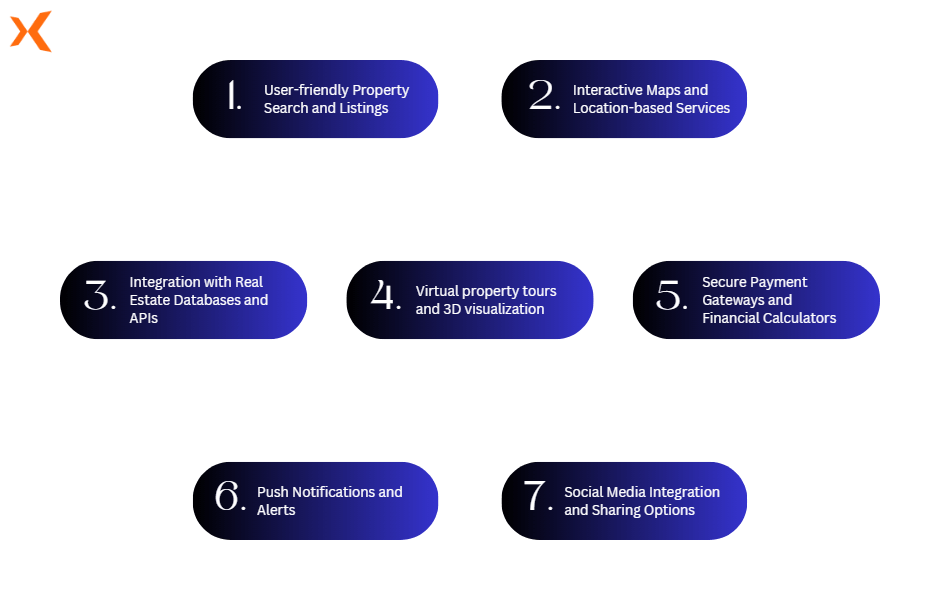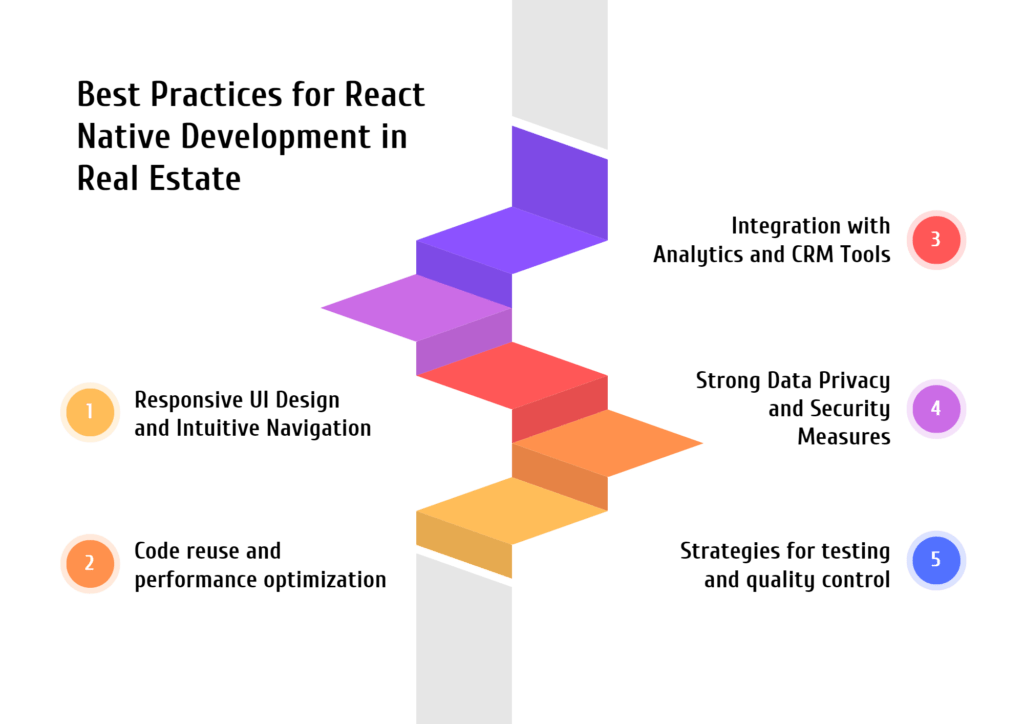
X-Strategy Services
Categories
Using React Native Development Services to Revolutionize Real Estate with Mobile Apps
Introduction
The real estate sector is quickly using technology to improve operations and attract a wider audience in the current digital era. For real estate professionals, mobile applications have evolved into essential tools that help them improve customer engagement, reduce procedures, and gain a competitive advantage. Due to its adaptability, efficacy, and affordability, React Native has become one of the most widely used frameworks for creating mobile apps. We’ll examine the advantages of utilizing React Native for real estate mobile app development in this blog post, as well as how React Native development services could completely transform the sector.
The Real Estate Industry’s Need for Mobile Apps
1. Benefits of Real Estate Mobile Apps
With their many benefits, mobile apps have completely changed the real estate business. These benefits are further enhanced when it comes to react native development services for real estate. Here are several major advantages:
- A well-designed mobile app can offer a seamless and simple user experience, making it simple for prospective buyers to browse properties, view high-resolution photographs, and access in-depth information. With its cross-platform features, React Native guarantees reliable performance and easy user interactions across a variety of devices and operating systems.
- Enhanced Property Search real estate brokers can provide sophisticated search capabilities through a mobile app, enabling consumers to filter properties based on their choices, including location, price range, number of bedrooms, and more. Additionally, the app has GPS capabilities that let users explore local properties and access current information.
- Visual Richness real estate brokers can use professional photos, virtual tours, and videos to market homes utilizing mobile apps. React Native’s capacity to make use of device-specific features guarantees that these visual components are optimized for various screen sizes and resolutions, providing potential customers with an immersive experience.
- Push Notifications and Alerts using mobile apps, real estate brokers can alert consumers to new listings, price adjustments, open houses, or pertinent market updates by sending push notifications and alerts to users. Push notification features in React Native enable quick and focused communication with prospective customers.
- Integration with CRM systems Real estate agents can manage leads, keep track of conversations, and streamline their sales process by integrating mobile apps with Customer Relationship Management (CRM) systems. The adaptability of React Native enables simple connection with current CRM systems or the creation of unique solutions catered to particular requirements.
2. Changing User Expectations and Behavior
The real estate sector must adjust to these developments because user behaviour and expectations have changed significantly in the current digital era. The use of mobile apps is now crucial for addressing these changing needs. Here are some examples of how React Native Development Services adapt to shifting user expectations and behaviour:
- Mobile apps give customers the convenience of obtaining real estate information whenever and wherever they choose. Real estate apps may be created with react native programming for both iOS and Android, offering greater user accessibility and reach.
- Users anticipate instant access to pertinent information, and mobile apps give just that. Real estate apps can instantly display property details, pricing, and availability thanks to React Native’s effective performance and low loading times, satisfying consumers’ need for rapid satisfaction.
- Personalization: Mobile apps provide tailored interactions by customizing search results and property recommendations based on user preferences and previous interactions. Delivering tailored content and recommendations is made easier by React Native’s capacity to interface with backend systems and make use of user data, increasing user engagement and happiness.
3. Enhanced Connectivity and Communication
Within the real estate sector, mobile apps have transformed networking and communication. Real-time communication and the establishment of stronger ties are made possible by the use of React Native development services. This is how:
- Instant Inquiries mobile apps make it easier for buyers and real estate agents to communicate directly. Through in-app messaging or contact forms, users can request more information, set up viewing appointments, or ask questions about homes. These interactions are streamlined and made easier by React Native’s integration with communication APIs, which guarantees quick responses.
- Seamless collaboration between buyers, sellers, and agents is made possible by features in real estate apps created using React Native. These features, which promote improved coordination and efficiency in real estate transactions, may include shared property portfolios, document sharing, and appointment scheduling.
- Networking Possibilities in the real estate industry, mobile apps can also foster networking opportunities. Real estate professionals can connect by including social media tools or specific forums.
- Share knowledge and work together on prospective business agreements. This networking component is made simpler by React Native’s ability to interface with numerous social media platforms.
Introducing React Native Development Services
1. Facebook’s open-source React Native framework enables developers to create mobile applications using JavaScript. React, a well-known JavaScript toolkit for creating user interfaces, is combined with native mobile components to create a hybrid app that can run on both iOS and Android operating systems.
2. React Native is a great option for development services since it has a number of advantages when it comes to real estate apps. First off, it offers a very responsive and native-like user experience, making sure that prospective house buyers or renters can simply browse property listings, examine photographs, and interact with the app without any issues.
3. Cross-platform compatibility is a major benefit of React Native for real estate apps. Developers can save time and effort by building apps that work on iOS and Android devices with a single codebase. As a result, there is no longer a need for two independent development teams, and the expense of maintaining two different codebases is decreased.
4. React Native’s ability to reuse components across several platforms further contributes to its cost effectiveness. This enables developers to use the same codebase across many platforms, cutting down on development time and project costs overall. Businesses can effectively allocate resources and optimize the development process by optimizing code reuse.
5. React The reusability of Native goes beyond simply sharing code. Due to the usage of the widely used programming language JavaScript, it also enables developers to reuse current web development abilities. This lowers the learning curve involved in developing native mobile apps and makes it simpler for businesses to recruit qualified developers.
Key Features and Functionalities of Real Estate Mobile Apps

To create a seamless user experience, it’s crucial to include important features and capabilities while creating a real estate mobile app. A real estate mobile app may benefit from the following features to be more effective:
1. User-friendly Property Search and Listings
A real estate mobile app should have a simple and user-friendly design that enables users to quickly search for homes in accordance with their preferences. Advanced search options like location, price range, property type, and amenities should be available. The app should also include comprehensive real estate listings with top-notch photos, descriptions, and contact details.
2. Interactive Maps and Location-based Services
Users can precisely visualize property locations thanks to the app’s integration of interactive maps and location-based services. Users are able to explore the area, neighbouring attractions, and crucial services like nearby hospitals, schools, and transit alternatives. Users can also establish preferences based on their geographic location to be notified when new listings are posted in certain areas.
3. Integration with Real Estate Databases and APIs
Integration with real estate databases and APIs is essential to ensuring that the app provides comprehensive and up-to-date property listings. Through this connectivity, the app can obtain data straight from MLSs or other pertinent sources, guaranteeing that users can access the newest properties.
4. Virtual property tours and 3D visualization
These features have the potential to dramatically improve the user experience. Users may browse floor plans, take virtual tours of homes, and get an accurate sense of the space. This function is very helpful for purchasers who are located far away or for those who wish to study the property in-depth before making a physical visit.
5. Secure Payment Gateways and Financial Calculators
Secure Payment Gateways should be linked within the app to make transactions easier. Users are now able to securely pay for real estate purchases, rents, or other related services. Users can also estimate mortgage payments, property taxes, and other financial components of their real estate deals by including financial calculators.
6. Push Notifications and Alerts
Push notifications are essential for keeping consumers interested and up to speed on pertinent information. On the basis of their search history and preferences, users can receive notifications about new real estate listings, price changes, open houses, and personalized suggestions. This function keeps users interested and raises conversion rates.
7. Social Media Integration and Sharing Options
The app’s reach is increased by social media integration, which makes it simple for users to share real estate listings with their network. Users can post items on social media sites like Facebook, Twitter, and Instagram that they find interesting. Users may also sign up or log in using their social network accounts thanks to this integration, which streamlines the onboarding procedure.
Share your idea or requirement with our experts.
Case Studies: Successful Real Estate Apps Built with React Native
React Native has demonstrated to be a potent and effective platform for creating real estate apps. Let’s look at three case studies that demonstrate how real estate apps developed with React Native development services have been successful:
App A: Streamlining Property Search and Booking
In this instance, React Native was used to develop a real estate app that transformed the method of searching for and booking properties. Users were able to search for properties based on their choices, including location, price range, and amenities, thanks to the app’s smooth integration with databases and listings for properties. The user-friendly layout and easy navigation made things simple. The software improved the overall effectiveness and simplicity of property search and booking by integrating cutting-edge features like real-time property availability updates and online booking.
App B: Streamlined Buyer-Agent Communication
The creation of an app that enabled smooth communication between real estate brokers and potential purchasers was made possible in large part thanks to React Native. The software had functions including video conferencing, instant messaging, and virtual tours of properties. The software was usable on both iOS and Android smartphones because to React Native’s cross-platform capabilities, enabling a wider reach. Quick and efficient communication was provided by the user-friendly user interface and real-time notifications, which improved engagement and increased customer satisfaction.
App C: Personalized Suggestions and Property Tracking
A real estate app with tailored suggestions and property tracking was developed using React Native development services. The app used machine learning techniques to offer properties that suited the user’s criteria by utilizing user data and preferences. A fluid browsing experience was made possible using React Native’s quick rendering capabilities, which allowed for seamless transitions and dynamic updates. Additionally, the app gave users the tools they needed to successfully manage their real estate search, keep tabs on their preferred properties, and get price change alerts.
Best Practices for React Native Development in Real Estate
There are a number of best practices that can improve the overall user experience and guarantee optimal performance when creating a React Native app for the real estate sector.
1. Responsive UI Design and Intuitive Navigation
Real estate apps must have a responsive user interface (UI) design. It is crucial to guarantee that UI elements adjust fluidly to various screen sizes and orientations. Delivering a consistent experience across different devices is possible by utilizing the layout components of React Native and responsive design strategies. Additionally, using user-friendly navigation patterns can increase user engagement and make it simpler for users to explore features and attributes, such as bottom tabs or drawer navigation.
2. Code reuse and performance optimization
Any mobile application’s success depends heavily on performance. Following best practices, such as avoiding the use of bulky libraries, utilizing React Native’s built-in optimizations (such as VirtualizedList for effective list rendering), and adopting code splitting strategies, will help your React Native app run faster. Additionally, you may effectively create and manage your program while minimizing redundant code by utilizing code reusability through componentization and modularization.
3. Integration with Analytics and CRM Tools
Integrating analytics tools is crucial to understanding user behavior and app performance. You can monitor user interactions, gauge conversion rates, and spot areas for improvement by using tools like Google Analytics or Firebase Analytics. Adding Customer Relationship Management (CRM) solutions also gives real estate brokers the ability to handle leads, monitor communication, and improve client engagement. You can easily incorporate these features into your app by using React Native’s native module framework.
4. Strong Data Privacy and Security Measures
Sensitive user information, such as personal information and property listings, is frequently handled by real estate apps. To safeguard user data from unwanted access and breaches, it is essential to implement strong security measures. Use HTTPS for secure communication, encrypt sensitive data while storing it, and put user authentication and permission methods in place. Update the libraries and dependencies used by your program frequently to patch any potential security flaws.
5. Strategies for testing and quality control
To guarantee that your software works dependably and lives up to customer expectations, thorough testing and quality assurance are essential. Use unit tests, integration tests, and end-to-end tests to cover various facets of the functionality of your software. Use testing tools supplied by React Native and frameworks like Jest. To automate testing and guarantee uniform quality across various app versions, take into account integrating continuous integration and delivery (CI/CD) pipelines.

Future Trends in Real Estate Mobile App Development
Several developments are slated to influence the real estate mobile app development industry’s future trends.
1. Integration of augmented reality (AR) and virtual reality (VR)
The real estate sector can be revolutionized by using React Native development services to take use of AR and VR technology. Potential buyers can virtually tour residences, see interior designs, and even experience neighborhoods by creating immersive experiences. Due to React Native’s adaptability, AR and VR functions may be seamlessly included into real estate mobile apps, increasing user engagement and boosting revenue.
2. Blockchain Technology for Transparent Transactions
Blockchain technology is gaining traction in the real estate industry as demand for safe and open transactions rises. Blockchain functionality may be incorporated into mobile apps using React Native development services, giving consumers access to verified property information, streamlining transactions, and building trust between buyers, sellers, and brokers. Blockchain’s decentralized structure guarantees data integrity and gets rid of middlemen, improving process efficiency and security.
3. Personalized property suggestions using artificial intelligence (AI)
React Native development services can make use of AI algorithms to offer users personalized property recommendations. AI-powered real estate mobile apps can provide customized property choices that match the user’s needs and preferences by examining user preferences, browsing history, and other pertinent data. Such tailored recommendations improve user experience and boost conversion rates.
4. Voice-enabled Interfaces and Chatbots
Voice-enabled interfaces and chatbots are the future of real estate mobile app development. Because React Native works with voice recognition software, developers can construct voice-enabled user interfaces that let people search for properties, ask questions, and get immediate answers. The use of chatbots that use natural language processing (NLP) improves customer service by enabling consumers to seek advice and replies quickly inside the app.
5. Enhanced Data Analytics and Machine Learning (ML) techniques
Native development services can make use of ML techniques to mine massive volumes of real estate data for insightful information. Mobile apps can give buyers, sellers, and brokers useful information by researching market trends, property values, and user activity. Additionally, ML algorithms may automate functions like property valuation, risk assessment, and fraud detection, improving the accuracy and efficiency of the real estate process.
Conclusion
Mobile apps created with React Native are changing how homes are searched for, purchased, and sold as the real estate sector adjusts to the digital landscape. Real estate companies have the chance to stay ahead of the competition and deliver seamless user experiences thanks to React Native development services’ great performance, cross-platform compatibility, and cost effectiveness. Real estate apps created with React Native are prepared to impact the future of the industry by including the essential features and functions covered in this blog and staying up to date with the most recent developments, creating a win-win situation for businesses and users alike.






